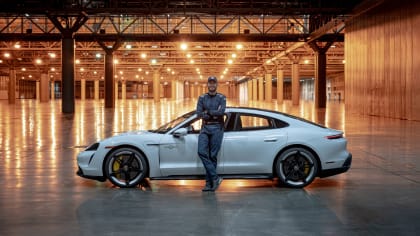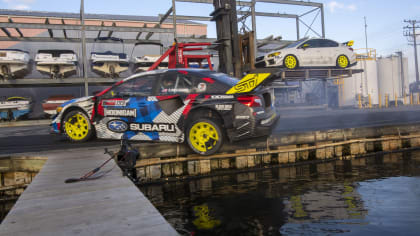1994 Nissan 300ZX IMSA GTS

The IMSA GT Powerhouse
Part 4 of the LACar ExtravaganZa dives into the epic story behind Nissan's replacement of the 280ZX: the Triple Crown winning 300ZX.
By Hector Cademartori
Wed, Sep 30, 2020 12:00 PM PST
Editor’s note: The gorgeous artwork at the top of this article was painted by Hector Cademartori, the ringleader of our ExtravaganZa. To see more of his work, check out HectorCademartori.com
This article is a part of
Nissan Z ExtravaganZa
Click to see the collection and all the included articles!
In the late ‘1980s, Electramotive’s GTP ZX-Turbo prototype dominated IMSA’s top class dethroning the legendary Porsche 962. In its footsteps, Nissan decided to campaign the new 300ZX as a replacement of their 280ZX in the GTO class. The production model was introduced in 1989 and the racing project was entrusted to Clayton Cunningham Racing in El Segundo, California. Technically, the race cars shared only the logos and the taillights with the production version. The IMSA machine was a 2,600-pound beast with a chromemoly tube-frame chassis, carbon fiber bodywork and a 750/800 HP V6.
Following the class rules, the 3 liter engine had the same casting as the production car, but it was cast in aluminum instead of iron, using the stock heads which were ported and had larger valves. Just as on the road car, it had two turbochargers, only these were big, howling Garrett units which, strangely enough, were eventually reduced in size to improve the racecar’s drivability.
The transmission was a 5-speed Hewland VGC transaxle and the car sported Yokohama tires, made specifically for this application that were mounted on BBS wheels to put the power on the ground.
Off-road ace Steve Millen and long-time Datsun-Nissan driver John Morton were recruited to handle the driving chores. After the first season, the team started to gain competitiveness and the 300ZXs became a feature at the top of the results pages fighting works Mazdas RX-7 and Mercury Cougars first and later Roush Racing’s Mustangs and Rocketsports Racing Olds’ after Mazda pulled out of GTO in 1992.
1992 was the year that Exxon became the official sponsor of the IMSA GT series and requested the name should be changed to GTS. Millen, with victories in Miami, Mid Ohio, New Orleans and Lime Rock won the championship and gave Nissan its first manufacturers’ title. By then, the team had added Jeremy Dale and Johnny O’Connell to its roster of drivers. In 1993, with some five years of development, the cars were deemed almost bulletproof. They won the 12 Hrs. of Sebring and placed third at Daytona.
Then, at Watkins Glen, Millen had a minor accident lapping the Argo of Brent O’Neill with both cars ending in the middle of the track when his teammate, Johnny O’Connell, came over the blind crest at over 150 mph and hit Millen sending him violently into the O’Neill car. Rescuers worked for almost an hour to extricate Millen from his car. The outcome was a fractured skull (in two places), a broken jaw, five ribs, an arm and damage in an ear drum and facial nerves.
The team finished the season running only O’Connell’s car. Millen, after four months of recovery, came back and tested the car in the last race at Phoenix to show the team that he was ready for the next season.
And he was.
He put the 300Zx #75 on pole in Daytona, the first race of 1994. Nine hours into the race, the crankshaft broke in the car that he was sharing with Morton and O’Connell and the team manager put Millen into the #76 sister car, which he took to the overall victory, along with Scott Pruett, Paul Gentilozzi and Butch Leitzinger.
Five weeks later, Millen, O’Connell and Morton repeated at the other Florida classic, the 12 Hrs of Sebring. The team finished the season winning the last three races: O’Connell in Laguna Seca and Phoenix and Millen in Portland giving Nissan a second GTS Manufacturer’s Championship, while Millen took home the driver’s cup as he had done in 1992.
For the 1995 season IMSA banned turbo engines but Nissan stayed in the series with the same car, now powered by a V8 atmospheric engine (borrowed from the Infinity Q45) and made its debut at the Daytona 24 Hrs. finishing 21st . But Nissan fans did not have to wait too long for a victory. The 300ZX V8 won its class at Sebring with Millen, Morton and O’Connell placing 5th overall.
Millen had another very close call at Road Atlanta when the Ferrari 333 prototype of Freddy Lienhard clipped him at 175 mph. This time he broke his neck and had to wear a halo brace while recuperating. Steve Millen, the winningest driver in IMSA GT history, never raced again. Johnny O’Connell finished the season with a couple of wins and DNFs, but it was all over for Cunningham Racing and the 300ZX racing program.
Nissan pulled out of IMSA at the end of 1995.
The 300ZX at Le Mans. Oh-la-la!
When doing research for a story about Datsun or Nissan racing, a serious journalist will do extensive research, digging deep in the Internet, going through books and old magazines.
The rest of us just call John Morton.
Let’s face it, nobody has been closer to the racing history of Datsun-Nissan than him. Besides, he has a good memory and he’ll tell you all you need to know laced with a pinch of sarcasm, which is also part of his storytelling style. (Just read his book “Inside Shelby American” and you’ll see what I mean.)
John was part of the team from the very beginning, and, by the way, includes nine 24 Hrs of Le Mans in his curriculum vitae. We’ll give him the floor here for a few laps:
MORTON: “We tested the car for the first time in Willow Springs without bodywork, just the chassis, and I didn’t like it at all. I didn’t like it the first year, 1989, either, but the car got better and better and became really good. Maybe it was that the first year we had Goodyear tires and they would go away pretty fast. When they switched to Yokohamas we didn’t have any more problems. Clayton also made the chassis longer and became much better.
We used three engines: the first one was the V6 push-rod two-valve from the Maxima, which was also the engine that the GTP car was running. Then we went to the 4-valve twin-cam engine, both twin turbos, and finally the V8 normally aspirated in 1995.
At the beginning we had a lot of problems with brakes, so much so that Clayton designed water-cooled brakes. The brake calipers had water jackets and we ran a pump and a water tank inside the car. Eventually that problem was solved and we went to regular brakes. The cars were very powerful but it was not that difficult to drive the twin turbos. By then the electronics were really good and it wasn’t as before when we had to anticipate the lag. Normally aspirated engines are usually much easier to drive than turbos and I was very impressed with the V8 in ’95.
In 1994, after the successes at Daytona and Sebring, somebody came up the idea of Le Mans. Nissan approved and the Cunningham team entered two cars in the “IMSA Class”, and was: Off to France!
The #75 car was Steve Millen, Johnny O’Connel and me, and the #76 car was handled by Eric van de Poele, Paul Gentilozzi and the Japanese driver, Sunji Kasuya. Their car caught fire in the morning warm up and was pretty badly damaged, but the team managed to repair it and they started the race.
In our team, Johnny got sick at the beginning of the race and was unable to drive so it was up to Steve and I. #76 developed ignition problems and run only 25 laps.
We had two situations during the race. I was in the car- continues Morton- and realized that I was having some transmission problems and went into the pits. They replaced the gearbox in 25 minutes. Then a camshaft broke and they took the cam and the pulley from the parked car and replaced it in less than half an hour. We were running fourth at the time against the prototypes and fell to fifth. Our main disadvantage was the top speed on the long Mulsanne straight. I believe they were doing about 210 mph and our top speed was about 190.
For that year Le Mans change the rules and didn’t allow prototypes, but the winners found a loophole in the rule book and showed up with a Dauer, which was a Porsche 962 sort of street legal with upholstery, and won the race. We finished 5th overall and won our class”.
There was only one other entry in the IMSA class, a Mazda RX-7 that finished 15th overall, but the 5th place of the 300ZX #75 behind “protos” and GT1 cars after overcoming technical failures was a testament of the drivers and crew.
The 300ZX came back from France winning, in the same year, the triple crown of endurance racing: Daytona, Sebring and Le Mans.
About The Author

Hector Cademartori honed his racing art in Buenos Aires. In 1983, he left his job with Corsa Magazine in Argentina and moved to Southern California to specialize in motor racing art. Today, you can find Hector’s art on Indianapolis 500 Yearbook covers, Laguna Seca Raceway, Auto Club Speedway and Carrera Panamericana posters, the NHRA, foreign and domestic automobile and motorcycle magazines, motorcycle manufacturers, Toyota Motorsports, TRD and Lucas Oil. Hector races his 1973 Datsun 240Z “Ferratsun” around the So Cal circuits, and a 1991 Volvo 740 Wagon with the 24 Hours of LeMons.






